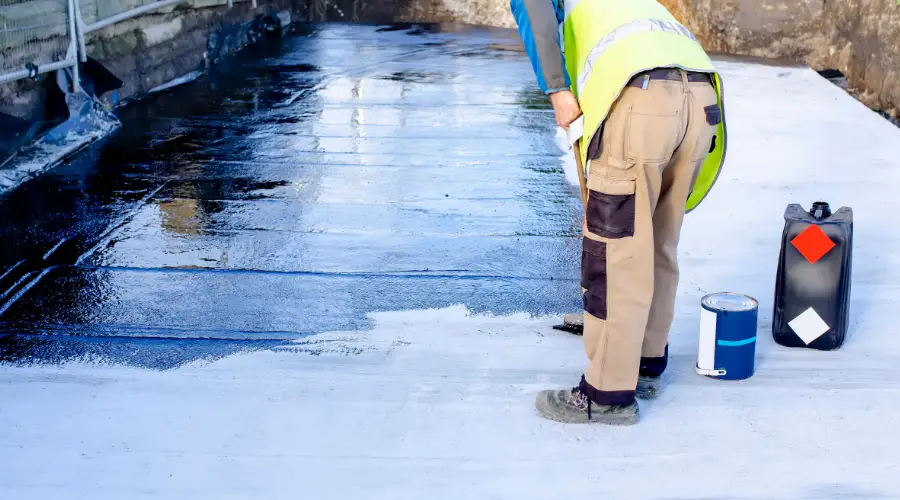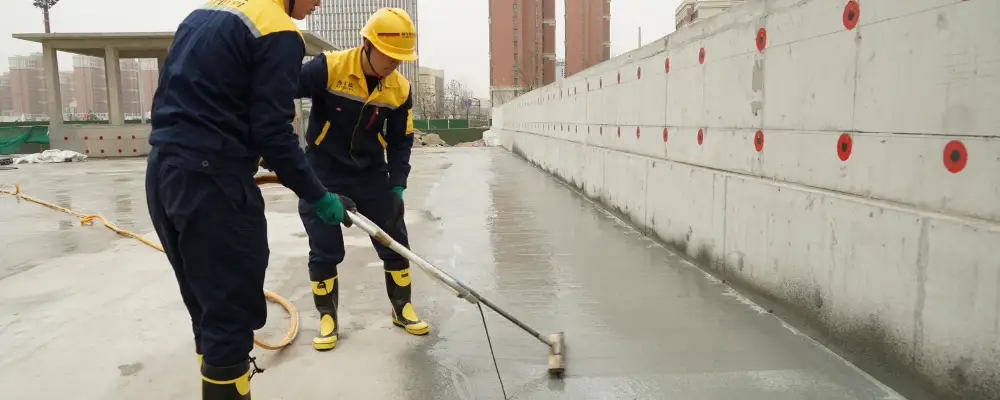Basement waterproofing is essential for every homeowner who is serious about protecting their basement against water issues, mold growth, and structural damage. Water drainage in basements can cause extensive damage to the structural integrity of your home as well as to the occupants of the house. This article will discuss the role of basement waterproofing in protecting our homes, common causes of basement leaks, various waterproofing methods, and how to determine the proper waterproofing solution for your home.
What is Basement Waterproofing?
Basement waterproofing is the process of protecting your basement (and crawl space) from water intrusion using specialized materials and techniques. The primary objective of basement waterproofing is to prevent water damage, control moisture levels, and more importantly, stop mold growth, all of which can compromise the structure of the building and negatively impact indoor air quality.
Waterproofing can be carried out on both the interior and exterior of the basement. For example: waterproof coatings and membranes can be applied to walls and floors to block moisture penetration. Sump pumps and sewer ejectors can be installed to redirect collected water away from the basement safely. All these processes are necessary to maintain a dry and structurally stable underground area, especially in zones that are frequently affected by water seepage.
Why Waterproofing Your Basement is Crucial
Basement waterproofing is important for many reasons:
- Prevention of structural damage – Water intrusion can negatively affect the foundation of your home, leading to cracks and settlement, which can compromise the structural integrity of your home. Additionally, it can become costly and result in deferred maintenance.
- Mold, mildew prevention – Your basement is likely the place to find mold or mildew. Basements are inherently damp, and the moist places in the home are hot spots for mold and mildew. Whether it’s mold, mildew, or any wet mess in the house, it can affect the health of you and your family. They can cause respiratory issues, allergies, asthma, or problems for others who may notice an impact on their immune system while they are in or around it..
- Better air quality – Any moisture buildup can be a breeding ground for odour and poor air quality. This is especially concerning if the basement is used as a living space, storage area, or home office.
- Greater property value – A waterproofed basement does add to your property value. Prospective home buyers are typically much more interested in a basement for use and storage purposes that is dry and free from moisture issues; when it comes to property value and selling your house, this proves to be very valuable.
Common Causes of Basement Water Seepage

The seepage of water in basements can result from numerous reasons such as;
- Poor Drainage – If the drainage around the foundation is poor—for example, due to improper grading or blocked gutters—it can cause water to pool against the basement walls. This pooled water increases hydrostatic pressure on the foundation, which can eventually force water through small cracks or openings in the walls.
- Cracked Foundations – Most foundations develop cracks over time due to natural settling, structural shifting, and environmental factors beyond the homeowner’s control. These cracks often allow water to seep through during heavy rainfall or snowmelt, leading to noticeable leaks in the basement
- Hydrostatic Pressure – When the soil surrounding the foundation becomes saturated, it exerts hydrostatic pressure on the foundation walls. This pressure can force water through cracks, joints, or porous areas in the concrete, making it one of the most common causes of basement water intrusion.
- Improperly installed or aging waterproofing systems – If the waterproofing system was not properly installed, aging or had cracked basement walls or leaking pipes, your waterproofing system would not stop the water from entering your basement.
Basement Waterproofing Methods
Effective basement waterproofing is critical to protect a building’s foundation from water damage, mold, and structural issues. Waterproofing methods generally fall into two main categories: exterior waterproofing to stop water before it reaches the foundation, and interior waterproofing to manage moisture once it has entered or is about to enter the basement. Combining methods from both categories often gives the best long-term protection.
1. Exterior Waterproofing Methods
Exterior waterproofing is applied by excavating around the foundation and treating the outside walls and surrounding soil to prevent groundwater intrusion.
- Waterproof Membranes and Coatings: A liquid rubber, bituminous or elastomeric membrane, or polymer membrane is sprayed or rolled onto the exterior foundation walls. This creates a continuous barrier that repels water from entering the concrete or masonry structure. The membrane must be durable, flexible, and resistant to soil chemicals.
- Exterior Drainage Systems (French Drains): Perimeter drainage trenches filled with gravel and containing perforated pipes collect groundwater away from the foundation walls and divert it to a safe discharge point. This reduces hydrostatic pressure on the basement walls.
- Soil Grading and Landscaping: Ensuring that the ground slopes away from the foundation helps direct surface water runoff away from the building, preventing water accumulation near basement walls.
- Foundation Crack Repairs: Exterior structural cracks are sealed with hydraulic cement or injected with waterproofing compounds to stop water entry at vulnerable points.
2. Interior Waterproofing Methods
Interior methods typically address moisture that has already infiltrated the basement or prevent seepage through a secondary barrier inside the structure.
- Interior Sealants and Coatings: Sealants such as epoxy, urethane, acrylic paints, or silicate-based densifiers are applied to interior walls and floors to fill pores, cracks, and create a moisture barrier. These coatings are ideal for minor water leakage control and reducing condensation.
- Interior Water Drainage Systems: A water drainage system or channel or French drain is installed beneath or along the edges of the basement floor. This system collects seeped water and channels it towards a sump pump, which actively removes water from the basement.
- Sump Pumps: Installed in a pit at the lowest basement point, sump pumps automatically pump out collected water from drainage systems to the exterior, preventing pooling and flooding. Battery backups provide continuous operation during power outages.
- Vapour Barriers: Sheets of plastic or foil are applied to interior walls or floors to prevent moisture vapour from diffusing into living spaces. These are especially useful in finished basements to control humidity and stop mold growth.
- Concrete Crack Injection: Cracks inside basement walls can be injected with waterproof epoxy or polyurethane resins to seal leaks and restore structural integrity.
3. Combined and Specialized Methods
- Box-Type Waterproofing: This approach combines interior drainage with exterior coatings and membranes to fully encapsulate the basement in a “waterproof box,” providing maximum protection.
- Insulated Waterproofing Systems: In areas where temperature control and moisture control are critical (such as telecom or electrical rooms), insulated membranes or panels offer an extra layer of protection.
- Basement Dehumidifiers: While not a waterproofing method per se, dehumidifiers reduce ambient moisture inside the basement, preventing condensation-related issues.
Advantages and Disadvantages of Waterproofing
Advantages:
- Prevents Water Damage: Proper waterproofing safeguards your home against water damage. Keep in mind that most instances of water damage will lead to structural damage and problems related to mold and mildew.
- Higher Value: Homes that have finished, waterproofed basements are usually easier to sell to a buyer, especially in areas that are higher risk for flooding.
- Health Benefits: Waterproofed basements reduce moisture, which is a major contributor to the potential for mold and mildew inside the home. Eliminating this risk is not only a benefit to your air quality and the health of you and your family.
- Long-term Savings: Preventing water damage before it occurs will typically save you money in the long run, both in terms of repair costs and potential health implications.
Disadvantages:
- Initial Cost: Waterproofing your home can have a high upfront cost, especially if you need to excavate a large amount of dirt and soil or if you purchase high-end materials for the job.
- Disruption During Installation: Certain waterproofing methods may involve some level of disruption to the landscaping and exterior of your home.
- Lifetime Maintenance: Some waterproofing systems, such as sump pumps, require regular maintenance throughout their lifespan to ensure optimal performance.
Choosing the Right Waterproofing Solution
When it comes time to choose a solution for waterproofing your basement, you’ll want to think about these few factors:
- Issue Severity: If your basement floods uncontrollably, exterior waterproofing will indeed be a viable option worth investigating. If you are experiencing light leaking or dampness, however, an interior waterproofing solution for your basement like a sump pump or a french drain may take care of your problem.
- Price: Depending on the method of waterproofing you choose, there will be quite a price variation. Exterior waterproofing is likely the most expensive option available, so you’ll want to be mindful of your budget and financial situation. Select a solution that aligns with both your budget and protection needs.
- Climate and Ground Soil: If you live in an area with heavier rainfall or a higher water table, you need to be cautious when choosing a waterproofing method that can counter and manage hydrostatic pressure.
- Property Use: If your basement is being used as a storage area, a zoned living space, or if damaged items in your basement have a short lifespan (such as electronics), you should seriously consider a comprehensive waterproofing solution.
Conclusion
Waterproofing your basement is important to prevent the damaging effects of water (and moisture), mold, & structural deterioration on your house. Knowing some of the common causes of water seepage and the waterproofing solutions available helps homeowners make informed decisions about the best waterproofing method for their specific needs. Proper waterproofing can not only improve the life span of your home but also add livable space, comfort, value, and eliminate or lessen expensive repairs.
FAQs
Basement waterproofing costs in India can vary significantly based on the method used, the size of the basement, and the extent of the water seepage problem. On average, homeowners can expect professional waterproofing services to cost anywhere between ₹50,000 to ₹4,00,000.
If properly installed, waterproofing can last for numerous years. Exterior waterproofing systems can last 20 to 30 years, whereas interior waterproofing systems typically require ongoing maintenance and upkeep every 5 to 10 years.
There are some DIY waterproofing methods, including the application of waterproof coatings, which are methods that homeowners can potentially use. More complicated waterproofing systems, like French drains or sump pumps, are generally too complicated for homeowners and are recommended to be completed by professionals.
The best method depends on what issues your home has. If your property has extreme water issues, exterior waterproofing is the best long-term solution. If there is minor water intrusion into your basement, installation of a sump pump or French drain may be the most cost effective waterproofing systems.

